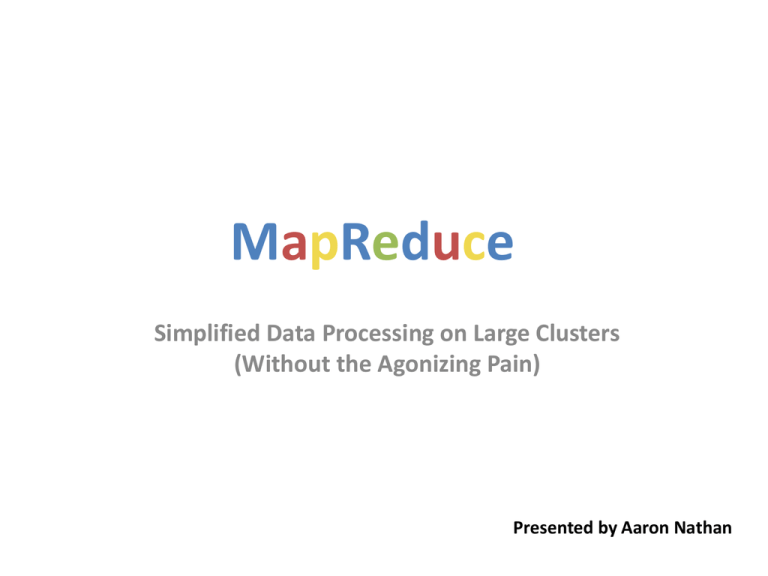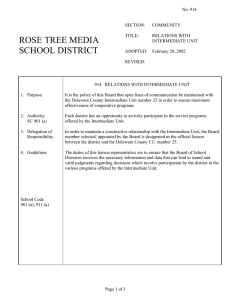M R d e
advertisement

MapReduce Simplified Data Processing on Large Clusters (Without the Agonizing Pain) Presented by Aaron Nathan The Problem • Massive amounts of data – >100TB (the internet) – Needs simple processing • Computers aren’t perfect – Slow – Unreliable – Misconfigured • Requires complex (i.e. bug prone) code MapReduce to the Rescue! • Common Functional Programming Model – Map Step map (in_key, in_value) -> list(out_key, intermediate_value) • Split a problem into a lot of smaller subproblems – Reduce Step reduce (out_key, list(intermediate_value)) -> list(out_value) • Combine the outputs of the subproblems to give the original problem’s answer • Each “function ” is independent • Highly Parallelizable Algorithm Picture DATA MAP MAP K1:v K1:v K2:v K2:v MAP K1:v MAP MAP K2:v K3:v K3:v aggregator K1:v,v,v K2:v,v,v K3:v,v,v REDUCE REDUCE REDUCE Answer! Answer! Answer! Some Example Code map(String input_key, String input_value): // input_key: document name // input_value: document contents for each word w in input_value: EmitIntermediate(w, "1"); reduce(String output_key, Iterator intermediate_values): // output_key: a word // output_values: a list of counts int result = 0; for each v in intermediate_values: result += ParseInt(v); Emit(AsString(result)); Some Example Applications • • • • • • Distributed Grep URL Access Frequency Counter Reverse Web Link Graph Term-Vector per Host Distributed Sort Inverted Index The Implementation • Google Clusters – 100s-1000s Dual Core x86 Commodity Machines – Commodity Networking (100mbps/1Gbps) – GFS • Google Job Scheduler • Library linked in c++ Execution The Master • Maintains the state and identify of all workers • Manages intermediate values • Receives signals from Map workers upon completion • Broadcasts signals to Reduce workers as they work • Can retask completed Map workers to Reduce workers. In Case of Failure • Periodic Pings from Master->Workers – On failure resets state of assigned task of dead worker • Simple system proves resilient – Works in case of a 80 simultaneous machine failures! • Master failure is unhandled. • Worker Failure doesn’t effect output (output identical whether failure occurs or not) – Each map writes to local disk only – If a mapper is lost, the data is just reprocessed – Non-deterministic map functions aren’t guaranteed Preserving Bandwidth • Machines are in racks with small interconnects – Use location information from GFS – Attempts to put tasks for workers and input slices on the same rack – Usually results in LOCAL reads! Backup Execution Tasks • What if one machine is slow? • Can delay the completion of the entire MR Operation! • Answer: Backup (Redundant) Executions – Whoever finishes first completes the task! – Enabled towards the end of processing Partitioning • M = number of Map Tasks (the number of input splits) • R = number of Reduce Tasks (the number of intermediate key splits) • W = number of worker computers • In General: – M = sizeof(Input)/64 MB – R = W*n (where n is a small number) • Typical Scenario: InputSize = 12 TB, M = 200,000, R = 5000 W = 2000 Custom Partitioning • Default Partitioned on intermediate key – Hash(intermediate_key) mod R • What if user has apriori knowledge about the key? – Allow for user-defined hashing function – Ex. Hash(Hostname(url_key)) The Combiner • If reducer is associative and communivitive – (2 + 5) + 4 = 11 or 2 + (5 + 4) = 11 – (15+x)+2=2+(15+x) • Repeated intermediate keys can be merged – Saves network bandwidth – Essentially like a local reduce task I/O Abstractions • How to get initial key value pairs to map? – Define an input “format” – Make sure splits occur in reasonable places – Ex: Text • Each line is a key/pair • Can come from GFS, bigTable, or anywhere really! – Output works analogously Skipping Bad Records • What if a user makes a mistake in map/reduce • And only apparent on few jobs.. • Worker sends message to Master • Skip record on >1 worker failure and tell others to ignore this record Removing Unnecessary Development Pain • Local MapReduce Implementation that runs on development machine • Master has HTTP page with status of entire operation – Shows “bad records” • Provide a Counter Facility – Master aggregates “counts” and displayed on Master HTTP page A look at the UI (in 1994) http://labs.google.com/papers/mapreduce-osdi04-slides/index-auto-0013.html Performance Benchmarks Sorting AND Searching Search (Grep) • Scan through 1010 100 byte records (1TB) • M = 15000, R = 1 • Startup time – GFS Localization – Program Propagation • Peak -> 30 GB/sec! Sort • • • • 50 lines of code Map->key + textline Reduce-> Identity M = 15000, R = 4000 – Partition on init bytes of intermediate key • Sorts in 891 sec! What about Backup Tasks? And wait…it’s useful! NB: August 2004 Open Source Implementation • Hadoop • http://hadoop.apache.org/core/ – Relies on HDFS – All interfaces look almost exactly like MapReduce paper • There is even a talk about it today! – 4:15 B17 CS Colloquium: Mike Cafarella (Uwash) Active Disks for Large-Scale Data Processing The Concept • Use aggregate processing power – Networked disks allow for higher throughput • Why not move part of the application onto the disk device? – Reduce data traffic – Increase parallelism further Shrinking Support Hardware… Example Applications • Media Database – Find similar media data by “fingerprint” • Real Time Applications – Collect multiple sensor data quickly • Data Mining – POS Analysis required adhoc database queries Approach • Leverage the parallelism available in systems with many disks • Operate with a small amount of state, processing data as it streams off the disk • Execute relatively few instructions per byte of data Results- Nearest Neighbor Search • Problem: Determine k items closest to a particular item in a database – Perform comparisons on the drive – Returns the disks closest matches – Server does final merge Media Mining Example • Perform low level image tasks on the disk! • Edge Detection performed on disk – Sent to server as edge image – Server does higher level processing Why not just use a bunch of PC’s? • The performance incease is similar • In fact, the paper essentially used this setup to actually benchmark their results! • Supposedly this could be cheaper • The paper doesn’t really give a good argument for this… – Possibly reduced bandwidth on disk IO channel – But who cares? Some Questions • What could a disk possibly do better than the host processor? • What added cost is associated with this mediocre processor on the HDD? • Are new dependencies are introduced on hardware and software? • Perhaps other (better) places to do this type of local parallel processing? • Maybe in 2001 this made more sense?

